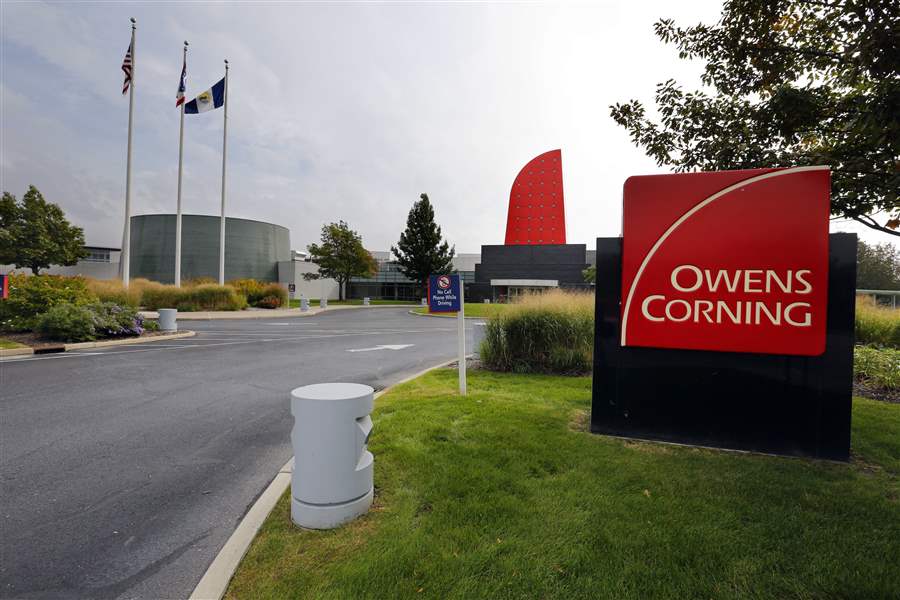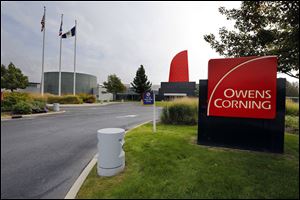
Owens Corning shares soar over past year
1/17/2018
Shares of Owens Corning are up by 83 percent in the last 12 months.
The Blade
Buy This Image
On Nov. 1, 2006, Toledo’s Owens Corning finally emerged from four years of floundering in Chapter 11 bankruptcy and resumed trading its stock on the New York Stock Exchange.
Its price that day was a promising $27.60 a share. Over the next 10 years, OC’s stock gained $23.96 — a respectable 87 percent gain.

Shares of Owens Corning are up by 83 percent in the last 12 months.
But over the last 12 months, Owens Corning’s shares are up $42.99, an 83 percent gain. And analysts say the maker of pink insulation, roofing shingles, and other building materials appears to have even more growth in it.
“We’re very happy with the financial results we’re producing but we really think the best is yet to come,” Mike Thaman, OC’s chairman and chief executive, told analysts at the company’s Investor Day in New York back in November.
To appreciate the loftier heights the company’s stock has reached now, one has to recall its previous depths.
Buried in asbestos claims, in December 2002 shares of the once-mighty Owens Corning dipped to 51 cents and the company was unceremoniously dumped by the New York Stock Exchange and relegated to lowly over-the-counter trading.
And even those OTC investors who bought in at a relatively cheap 50 cents a share lost money. In January 2003 its stock dropped to 12 cents a share.
But since December, 2016, Owens Corning has been on a steady rise and KeyBanc Capital Markets analyst Ken Zener recently raised his earlier predicted share price estimate of $95 to a new $115 a share target.
“We are raising our [price target] … following International Builder Show comments on price trends and demand,” he wrote.
The analyst said he expects increased insulation sales to elevate OC’s earnings margins, and sustained growth in new construction and repairs to fuel building-product demand.
Mr. Zener gave OC a rating of Overweight — an expectation that the stock will outperform the analyst’s estimates over the coming six to 12 months.
Zacks Investment Service also recently said that Owens Corning might be “well-positioned for future earnings growth” after posting earnings-per-share growth of 41.3 percent last year.
“Furthermore, the long-term growth rate is currently an impressive 15.3 percent, suggesting pretty good prospects for the long haul,” Zacks analysts wrote. Zacks ranked OC as one of its No. 2 buys and raised its share price target to $102.
Analyst Kathryn Thompson, of Thompson Research Group in Nashville, said Owens Corning is benefiting from almost 90 percent industry capacity in its basic markets of insulation and roofing.
“That certainly helps with pricing,” she said. “Then, from a global standpoint for composites, composites are also at very high capacity rates. We won’t see any new capacity come online anytime soon.”
Owens Corning has also been helped by storm damage, including last year’s Hurricane Harvey in Texas and Hurricane Irma in Florida, that has driven up roofing sales since 2016.
“The final point is what they've done from an acquisition standpoint. They’ve done a very nice job with their acquisitions,” Ms. Thompson said.
OC acquired InterWrap, a maker of roofing underlayment materials, for $452 million in mid-2016; Pittsburgh Corning, which makes insulation, for $560 million in early 2017, and Paroc Group, a European mineral wool manufacturer, for $1.04 billion in October.
“What all those three acquisitions are is a really good example of adding complementary products to your existing core businesses,” Ms. Thompson said. “They are all nice margin enhancement opportunities and it helps them get into new geographic markets.”
Owens Corning in 2017 was on a “show me; don’t tell me’ journey,” the analyst said. It has 126 percent free cash flow the last two years, a return on capital that has more than doubled since 2012, and adjusted operating earnings that have more than doubled since 2014.
“They really are showing people,” she said.l
Like Mr. Zener, Ms. Thompson said she too raised her share-price target to $102 from a previous $89.
“We still haven’t seen the full effect of these acquisitions that they made. So I don’t think we’ve seen the end of this just yet,” she said.
Contact Blade Business Writer Jon Chavez at jchavez@theblade.com or 419-724-6128.